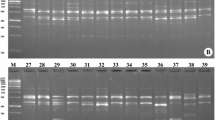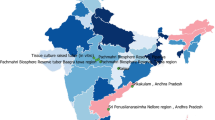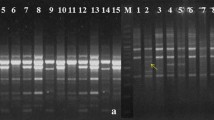Abstract
Total synthesis of podophyllotoxin is an expensive process and availability of the compound from the natural resources is an important issue for pharmaceutical companies that manufacture anticancer drugs. In order to facilitate reasoned scientific decisions on its management and conservation for selective breeding programme, genetic analysis of 28 populations was done with 19 random primers, 11 ISSR primers and 13 AFLP primer pairs. A total of 92.37 %, 83.82 % and 84.40 % genetic polymorphism among the populations of Podophyllum were detected using RAPD, ISSR and AFLP makers, respectively. Similarly the mean coefficient of gene differentiation (Gst) were 0.69, 0.63 and 0.51, indicating that 33.77 %, 29.44 % and 26 % of the genetic diversity resided within the population. Analysis of molecular variance (AMOVA) indicated that 53 %, 62 % and 64 % of the genetic diversity among the studied populations was attributed to geographical location while 47 %, 38 % and 36 % was attributed to differences in their habitats using RAPD, ISSR and AFLP markers. An overall value of mean estimated number of gene flow (Nm) were 0.110, 0.147 and 0.24 from RAPD, ISSR and AFLP markers indicating that there was limited gene flow among the sampled populations.
Similar content being viewed by others
Reference
Ajmone, Marsan P, Castiglioni P, Fusari F, Kuiper M and Motto M (1998). Genetic diversity and its relationship to hybrid performance in maize as revealed by RFLP and AFLP markers. Theor Appl Genet. 96: 219–227.
Alam MA, Pallavi G, Gulati AK, Mishra GP and Naik PK (2008). Characterization of genetic structure of Podophyllum hexandrum populations-an endangered medicinal herb of Northwestern Himalaya using ISSRPCR markers and its relatedness with podophyllotoxin content. African journal of Biotechnology. 7(8): 1028–1040.
Anon (1970). Podophyllum hexandrum. The wealth of India: A Dictionary of Indian Raw Material and industrial products: Raw Materials. Vol. VIII: Ph.Re. Publication and Information Directorate. CSIR, New Delhi. pp. 170–174.
Barker JHA, Matthes M, Arnold GM, Edwards KJ, Ahman I, Larsson S and Karp A (1999). Characterization of genetic diversity in potential biomass willows (Salix spp.) by RAPD and AFLP analyses. Genome 42: 173–183.
Broomhead AJ and Dewick PM (1990). Tumor inhibitory aryltralin lignans in Podophyllum versipelle, Diphyllcia cymosa and Diphyllicia grayi. Phytochemistry 29: 3831–3837.
Chatterjee R (1952). Indian Podophyllum. Econ. Bot. (Indian). 6: 342–354.
De Knijff P, Denkers F, van Swelm ND, and Kuiper M (2001). Genetic affinities within the herring gull Larus argentatus assemblage revealed by AFLP genotyping. J. Mol. Evol. 52: 85–93.
Excoffier L, Smouse PE and Quattro JM (1992). Analysis of molecular variance inferred from metric distance among DNA haplotypes: application to human mitochondrial DNA restriction data. Genetics 131: 479–491.
Fahima T, Roder MS, Wendehake K, Kirzhner VM and Nevo E (2002). Microsatellite polymorphism in natural population of wild emmer wheat, Trititum dicoccoides in Israel. Theor. Appl. Gent. 104: 17–29.
Fay DA and Ziegler HW (1985). Botanical source differentiation of Podophyllum resin by high performance liquid chromatography. J liq Chromatogr 8: 1501–1506.
Felsenstein J (1995). Phylogenies from restriction sites, a maximum likelihood approach. Evolution. 46: 557–574.
Fritsch PW and Rieseberg LH (1996). The use of random amplified polymorphic DNA (RAPD) in conservation genetics. In T. Smith and B. Wayne (eds.), Molecular Genetic Approaches in Conservation, pp. 54–73. Oxford Univ. Press, New York.
Fu L-G (1992). Plant Red Book of China: Rare Threatened Plants, Science Press, Beijing, pp. 184–185.
Fu YB, Phan AT, Coulman B and Richards KW (2004). Genetic diversity in natural populations and corresponding seed collections of little bluestem as revealed by AFLP markers. Crop Sci. 44: 2254–2260.
Hamrick JL and Godt MJW (1996). Conservation genetics of endemic plant species. Pp. 281–304. In Avise JC and JL Hamrick (eds). Conservation Genetics, Chapman and Hall, New York.
Han TH, Jeu MD, Eck HV and Jacobsen E (2000). Genetic diversity of Chilean and Brazilian Alstroemeria species assessed by AFLP anaslysis. Heredity. 84: 564–569.
Imbert TF (1998). Discovery of podophyllotoxins. Biochimie 80: 207–22.
Janssen P, Coopman R, Huys G, Swings J, Bleeker M, Vos P, Zabeau M and Kersters K (1996). Evaluation of the DNA fingerprinting method AFLP as a new tool in bacterial taxonomy. Microbiol. 142: 1881–1893.
Kazan K, Manners JM and Cameron DF (1993). Genetic variation in agronomically important species of Stylosanthes determine using random amplified polymorphic DNA markers. Theor. Appl. Genet. 85: 882–288.
McGregor CE, Lambert CA, Greyliing MM, Louw JH and Warnich L (2000). A comparative assessment of genetic diversity in dent and pocorn (Zea mays) inbred lines using inter-simple sequence repeat (ISSR) amplification. Mol. Breed. 1: 365–373.
Myburg AA, O’Malley D, Sederoff RR and Whetten R (2000). Highthroughput multiplexed AFLP analysis of interspecific hybrids of Eucalyptus trees species. Plant & Animal Genome VIII conference, San Diego, CA, p 544.
Na HJ, Um JY, Kim SC, Koh KH, Hwang WJ, Lee KM, Kim CH and Kim HM (2004). Molecular discrimination of medicinal Astragali radix by RAPD analysis. Immunopharmacol Immunotoxicol 26: 265–272
Odat N, Jetschke G and Hellwig FH (2004). Genetic diversity of Ranunculus acris L. (Ranunculaceae) populations in relation to species diversity and habitat type in grassland communities. Mol. Breed. 2: 225–238.
Prevost A and Wilkinson MJ (1999). A new system of comparing PCR primers applied to ISSR fingerprinting of potato cultivars. Theo Appl Genet. 98: 107–112.
Russel JR, Fuller JD, Macaulay M, Hatz BGB, Jahoor A, Powell W and Waugh R (1997). Direct comparison of level of genetic variation among barley accessions detected by RFLPs, AFLPs, SSRs and RAPDs. Theor. Appl. Genet. 95: 714–722.
Saghai-Maroof MA, Soliman KM, Jorgensen RA and Allard RW (1984). Ribosomal spacer length in barley: Mendelian inheritance, Chromosomal location and population dynamics. Proc. Natl. Acad. Sci. (USA) 81:8104–8118.
Sharma SK, Knox MR and Ellis THN (1996). AFLP analysis of the diversity and phylogeny of Lens and its comparison with RAPDanalysis. Theoretical and Applied Genetics 93(5–6): 751–758.
Sharma TR, Singh BM, Sharma NR and Chauhan RS (2000). Identificatin of high podophyllotoxin producing biotypes of Podophyllum hexandrum form north-western Himalaya. J. Plan Biochem. & Biotech. 9: 49–51.
Slatin M (1987). Gene flow and geographic structure of natural populations. Science (Washington, DC) 236: 787–792.
Sneath PHA and Sokal K (1973). Numerical Taxonomy, pp. 100–308.
Stahelin HF and Wartburg AV (1991). The chemical and biological route form podophyllotoxin glucoside to etoposide: Ninth Cain Memorail Award Lecture. Cancer Res. 51: 5–15.
Vos PR, Hogers M, Bleeker M, van de Lee Reijans T, Hornes M, Fritjers A, Pot J, Peleman J, Kuiper M and Zabeau M (1995). AFLP: a new concept for DNA fingerprinting. Nucleic Acids Res. 23: 4407–4414.
Wang X, Li Y, Li H, Zhang Y, Zhao L and Yu Y (2003). RAPD analysis of genuineness on source of Bupleurum chinense. Zhong Yao Cai 26: 855–856
Williams JGK, Kubelik AR, Livak KJ, Rafalski JA and Tingey SV (1990). DNA Polymorphisms amplified by arbitrary primers and useful as genetic markers. Nucl Acids Res. 18: 6531–6535.
Ying TS (1979). On Dysosma Woodson and Sinopodophyllum Ying, gen. nov. of the Berberidaceae. Acta Phytoxon. Sin. 17: 15–23.
Zietkiewicz E, Rafalski A and Labuda D (1994).Genome fingerprinting by simple sequence repeat (SSR)-anchored polymerase chain reaction amplification. Genomics 20: 176–183.
Author information
Authors and Affiliations
Corresponding author
Rights and permissions
About this article
Cite this article
Naik, P.K., Alam, M.A., Singh, H. et al. Assessment of genetic diversity through RAPD, ISSR and AFLP markers in Podophyllum hexandrum: a medicinal herb from the Northwestern Himalayan region. Physiol Mol Biol Plants 16, 135–148 (2010). https://doi.org/10.1007/s12298-010-0015-9
Published:
Issue Date:
DOI: https://doi.org/10.1007/s12298-010-0015-9




